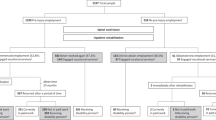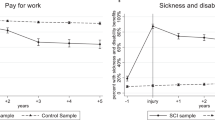Abstract
Study design
Cross-sectional.
Objectives
(1) Identify changes in employment status and earnings after spinal cord injury (SCI). (2) Estimate annual indirect costs and lifetime indirect costs due to lost earnings for various age and neurologic categories of those with SCI. (3) Compare our estimates with previous research.
Setting
Medical university in southeastern United States.
Methods
A population-based cohort of 307 participants met eligibility criteria of: (1) residual impairment resulting from traumatic SCI, (2) at least 1 year post injury, (3) between 23 and 64 years old at time of injury, (4) <65 years old at time of measurement, and (5) complete information on injury level, injury completeness, employment status, and earnings before and after injury. Main outcomes were employment status and earnings at the time of injury and post injury. Earnings were adjusted for inflation and the value of fringe benefits.
Results
Employment rate decreased from 87% at the time of injury to 35% after injury. Average annual indirect costs were $29,354 in 2019 dollars. Lifetime indirect costs for persons injured at age 25 varied by severity of injury, ranging from 0.5 to 2.3 million dollars. Lifetime indirect costs for persons injured at age 50 ranged from 0.3 to 0.6 million dollars.
Conclusions
Our estimate of indirect costs is lower than the previously estimated number. However, the higher unemployment rate and decreased earnings after SCI still make a heavy economic burden. With improvements in employment outcomes after SCI, the indirect costs affecting individuals, their families, and society can be further reduced.
Similar content being viewed by others
Log in or create a free account to read this content
Gain free access to this article, as well as selected content from this journal and more on nature.com
or
Data availability
The data sets generated and/or analyzed during the current study are not publicly available due to the privacy concerns of study participants and are not standardized to be in a publicly interpretable format.
References
Berkowitz M, Harvey C, Greene C, Wilson S. The economic consequences of traumatic spinal cord injury. New York: Demos Medical Publications; 1992.
Krueger H, Noonan VK, Trenaman LM, Joshi P, Rivers CS. The economic burden of traumatic spinal cord injury in Canada. Chronic Dis Inj Can. 2013;33:113–22.
Berkowitz M. Economic consequences of spinal cord injury. New Brunswick, NJ: Bureau of Economic Research; 1985.
Hartunian NS, Smart CN, Thompson MS. The incidence and economic costs of major health impairments: a comparative analysis of cancer, motor vehicle injuries, coronary heart disease, and stroke. Lexington, MA: Lexington Books; 1981.
Hodgson TA, Meiners MR. Cost-of-illness methodology: a guide to current practices and procedures. Milbank Mem Fund Q Health Soc. 1982;60:429–62.
Papadakaki M, Stamouli M, Ferraro OE, Orsi C, Otte D, Tzamalouka G, et al. Hospitalization costs and estimates of direct and indirect economic losses due to injury sustained in road traffic crashes: Results from a one-year cohort study in three European countries (The REHABILAID project). Trauma 2017;19:264–76.
Koopmanschap MA, Rutten FF, van Ineveld BM, van Roijen L. The friction cost method for measuring indirect costs of disease. J Health Econ. 1995;14:171–89.
DeVivo M, Whiteneck G, Charles E. The economic impact of spinal cord injury. In: Stover S, DeLisa J, Whiteneck G, editors. Spinal cord injury: clinical outcomes from the model systems. Gaithersburg: Aspen Publishers; 1995.
DeVivo MJ, Chen Y, Mennemeyer S, Deutsch A. Costs of care following spinal cord injury. Top Spinal Cord Inj Rehabil. 2011;16:1–9.
Cao Y, Chen Y, DeVivo M. Lifetime direct costs after spinal cord injury. Top Spinal Cord Inj Rehabil. 2011;16:10–6.
Cao Y, Selassie AW, Krause JS. Risk of death after hospital discharge with traumatic spinal cord injury: a population-based analysis, 1998–2009. Arch Phys Med Rehabil. 2013;94:1054–61.
US Bureau of Labor Statistics. Continuous occupational and industry series September 1975–December 2019. 2019. https://www.bls.gov/web/eci/ecicois.txt.
US Bureau of Labor Statistics. Employer costs for employee compensation news release. 2008. https://www.bls.gov/news.release/archives/ecec_06112008.htm.
US Bureau of Labor Statistics. Employer costs for employee compensation news release. 2016. https://www.bls.gov/news.release/archives/ecec_06092016.htm.
Arias E. United States life tables, 2008. Hyattsville, MD: National Center for Health Statistics; 2012.
Krause JS, Kewman D, DeVivo MJ, Maynard F, Coker J, Roach MJ, et al. Employment after spinal cord injury: an analysis of cases from the model spinal cord injury systems. Arch Phys Med Rehabil. 1999;80:1492–500.
Hirsch AT, Molton IR, Johnson KL, Bombardier C, Jensen MP. The relationship of chronological age, age at injury, and duration of injury to employment status in individuals with spinal cord injury. Psychol Inj Law. 2009;2:263–75.
Krause JS, Edles P, Charlifue S. Changes in employment status and earnings after spinal cord injury: a pilot comparison from pre to post injury. Top Spinal Cord Inj Rehabil. 2011;16:74–9.
Chapin M, Kewman D. Factors affecting employment following spinal cord injury: a qualitative study. Rehabil Psychol. 2001;46:400–16.
Schonherr MC, Croothoff JW, Mulder GA, Schoppen T, Eisma WH. Vocational reintegration following spinal cord injury: expectations, participation and interventions. Spinal Cord. 2004;42:177–84.
Krause JS, Terza JV. Injury and demographic factors predictive of disparities in earnings after spinal cord injury. Arch Phys Med Rehabil. 2006;87:1318–26.
Krause JS, Terza JV, Erten M, Focht KL, Dismuke CE. Prediction of postinjury employment and percentage of time worked after spinal cord injury. Arch Phys Med Rehabil. 2012;93:373–5.
Funding
The contents of this publication were developed under grants from the South Carolina Spinal Cord Injury Research Fund (SCSCIRF) grants SCIRF 11-006, SCIRF 09-001, and SCIRF 2017 SI-02. However, those contents do not necessarily represent the policy of the SCSCIRF, and you should not assume endorsement by the state of South Carolina.
Author information
Authors and Affiliations
Contributions
YC was responsible for the analyses and research methods sections and contributed to the results, discussion, and conclusion sections. JSK was the principal investigator and was responsible for the research design and contributed to the discussion and overall development and editing of the manuscript.
Corresponding author
Ethics declarations
Conflict of interest
The authors declare that they have no conflict of interest.
Ethics
We certify that all applicable institutional and governmental regulations concerning the ethical use of human volunteers were followed during the course of this research.
Additional information
Publisher’s note Springer Nature remains neutral with regard to jurisdictional claims in published maps and institutional affiliations.
Supplementary information
Rights and permissions
About this article
Cite this article
Cao, Y., Krause, J.S. Estimation of indirect costs based on employment and earnings changes after spinal cord injury: an observational study. Spinal Cord 58, 908–913 (2020). https://doi.org/10.1038/s41393-020-0447-1
Received:
Revised:
Accepted:
Published:
Issue date:
DOI: https://doi.org/10.1038/s41393-020-0447-1
This article is cited by
-
Socioeconomic consequences of traumatic and non-traumatic spinal cord injuries: a Danish nationwide register-based study
Spinal Cord (2022)
-
Epidemiology of traumatic spinal cord injuries in Colombia
Spinal Cord Series and Cases (2021)
-
The association between secondary health conditions and indirect costs after spinal cord injury
Spinal Cord (2021)



